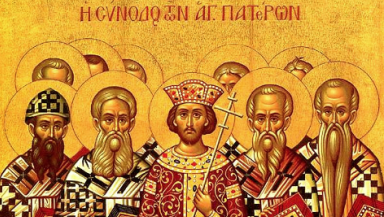
Today, the role of leaders and their influence on the moral tone and direction of a nation is very much in the news headlines and part of national conversations. This is not new and questions about the role of national leadership and how it relates to the gospel have been very significant in the past too. However, for the first three centuries of the history of Christianity, the Christian community had very little influence in the corridors of power and was subject to periods of lethal persecution.
Its very origins had been in the actions of one who had suffered humiliating death at the hands of influential elites and many of its early members came from the most marginalised sections of society.
Indeed, Paul had tellingly written: "Not many of you were wise by human standards, not many were powerful, not many were of noble birth. But God chose what is foolish in the world to shame the wise; God chose what is weak in the world to shame the strong; God chose what is low and despised in the world, things that are not, to reduce to nothing things that are" (1 Corinthians 1:26-8 NRSV).
This began to change in the fourth century when the Roman Empire became officially Christian. From that period onward, the attitudes of rulers towards the faith played an increasing role in the expansion of Christianity, and this had both positive and negative effects. The positive included the end of persecution and support for Christian communities. The negative included the co-opting of – what had once been – a radical and counter-cultural community as an arm of the state. The mixed impact of that is still with us.
We often associate this with the changes that occurred within the Roman Empire and later spread out as (so-called) barbarian successor states to Rome, in Western Europe, converted and their kings and queens adopted (and then supported) the Christian faith. In fact, early Christian missionaries often deliberately targeted royal courts in these kingdoms, based on their success with working with the Roman imperial authorities after the empire converted to the faith.
However, this process was not confined to there and it did not start there. In the east, the expansion of the faith beyond the borders of the Roman Empire had occurred much earlier, and there too it had involved the actions of rulers who converted.
Armenia leads the way
While most people will have heard of the Roman Emperor Constantine the Great (in power 306–37), the ruler of the kingdom of Armenia was converted well before the official conversion of the Roman Empire.
In the Roman Empire, Constantine the Great's Edict of Milan (313) stopped the persecution of Christians and decriminalized Christian worship. This edict effectively made the empire officially neutral regarding religious worship and did not make Christianity the official imperial religion. This did not occur until the Edict of Thessalonica of 380. Between 313 and 380 the profile, status, and influence of the faith increased and accelerated but it was not the official state religion until decades after the reign of Constantine.
That place in history belongs to Armenia – situated south of the great mountain range of the Caucasus. While the extent of this kingdom fluctuated greatly over time, at its height Armenian territory extended from the south-central Black Sea coast to the Caspian Sea; and from the Mediterranean to Lake Urmia in present-day Iran.
Here the key figure was Tiridates III (king 298–c. 330). In 301 he proclaimed Christianity as the state religion of Armenia, making the Armenian kingdom the first state to officially embrace Christianity.
Tiridates III was the son of Khosrov II of Armenia, who was assassinated in 252. Armenia was situated in a contested border zone between the Roman Empire and the Parthian (and then Sassanian) Empire located in modern Iran. Khosrov had been murdered by a Parthian agent. Following this, baby Tiridates was sent to Rome where he was under imperial protection (and patronage) and was educated in Roman style.
When Tiridates became king, he continued the traditional Zoroastrian faith of the state. However, this dramatically changed in 301 when he converted to Christianity. The reasons for this are shrouded in legend. One account, based on the fifth-century work of Agathangelos, "The History of the Armenians," involves the witness to the king of the son of his father's assassin.
This man, according to the story, had converted to Christianity and was overcome by remorse concerning his father's act. His prayers cured the king when he fell ill. The same tradition weaves in a love interest, with Tiridates attracted to a beautiful Christian woman who had fled the persecution of Christians that was occurring in the Roman Empire under Emperor Diocletian (ruled 284–305).
Modern historians have suggested that the move may have been partly motivated by opposition to the Sassanian Empire and as a way of defying their rulers and differentiating Armenia from the Sassanian regime and its influence. Whatever the truth of this, it was the beginning of the Armenian Apostolic Church, part of the Oriental Orthodox Church and one of the oldest Christian institutions in the world.
Followed by Aksum in Africa
After Armenia, the next kingdom to convert was in Africa. Christianity was not brought to Ethiopia by European missionaries (unlike many other African countries) in much later periods of history. Instead, King Ezana II (ruler perhaps from the 320s-c.360), king of Aksum (or Axum) converted to Christianity in around 340 and the country has embraced a form of Orthodox Christianity as their religion ever since.
While this was four decades later than Armenia, it was still about forty years before the Roman Empire became officially Christian. It should be noted that there are various different chronologies regarding this king and this event.
Tradition states that this conversion occurred through Ezana's Greek slave-teacher, Frumentius. Frumentius originated in the Phoenician city of Tyre (in modern Lebanon) and was enslaved during a journey along the Red Sea coast. He became an adviser to the court at Aksum and, in this position, a tutor to Ezana, when he was crown prince.
Ezana carried the royal title of "King of Saba and Salhen, Himyar and Dhu-Raydan" (areas of Yemen over which the kings of Aksum claimed the right to rule). Aksum was situated in the highlands of northern Ethiopia, in the modern-day Eritrea and Tigray regions.
The origins of the kingdom of Aksum are mysterious, but there is some evidence to suggest that migrants from the kingdom of Saba – across the Red Sea on the southern part of the Arabian Peninsula – may have migrated into the area in the first millennium BC.
This movement seems to have influenced the culture of Aksum and was reflected in the expansive royal titles of its rulers. By the time of Ezana, the kingdom dominated much of the Red Sea coast of what is now Djibouti and Somalia.
The kingdom was strategically positioned in an advantageous place, at the crossroads of trade routes which ran from the East African coast to the continent's interior. It exported gold and ivory, along with tortoise shells, rhino horns, frankincense, myrrh, emeralds, salt, and slaves.
Alongside Constantine the Great of Rome, and Tiridates of Armenia, King Ezana was one of the first rulers to convert to Christianity and he made this clear on his coinage. Ezana signalled his new faith through the crosses he ordered to appear on (mainly gold or silver) Aksumite coins.
The association of the cross with imperial rule made it politically, as well as religiously, very acceptable to the rulers who lived beyond the borders of the empire (or who were its successors when it collapsed in the West), as they converted to Christianity. When the cross appeared on the coins of Aksum, it was the first time that the Christian cross had ever featured on coinage. Africa led the way in this.
The Aksumite rulers promoted Christianity by military force too. In the sixth century, King Kaleb sent an army across the Red Sea to subdue the Yemenites. They were made his vassals for several decades. This action was supported by the Eastern Roman (Byzantine) Empire in retaliation for Yemen's persecution of Christians. It is an insight into how conversion could impact on foreign policy – even military action – as well as on faith.
Royal conversion was very important in defending and spreading the faith. It was also complicated and controversial in some of its effects, as time would reveal. As a result, a marginalised faith soon became the faith-of-choice of rulers in a large number of nations following the collapse of the Roman Empire in the west. This was to have far-reaching consequences for the future of Christianity in these emerging nations, which still influences culture and politics in the 21st century.
Martyn Whittock is an evangelical historian and a Licensed Lay Minister in the Church of England. As the author, or co-author, of fifty-four books, his work covers a wide range of historical and theological themes. In addition, as a commentator and columnist, he has written for several print and online news platforms; has been interviewed on radio and TV news exploring the interaction of faith and politics; appeared on Sky News discussing political events in the USA; and recently has been interviewed regarding the war in Ukraine, including its religious dimensions. His most recent books include: The Secret History of Soviet Russia's Police State (2020), Daughters of Eve (2021), Jesus the Unauthorized Biography (2021), The End Times, Again? (2021) and The Story of the Cross (2021). He is also interested in early medieval society, having written several books on this period of history.













